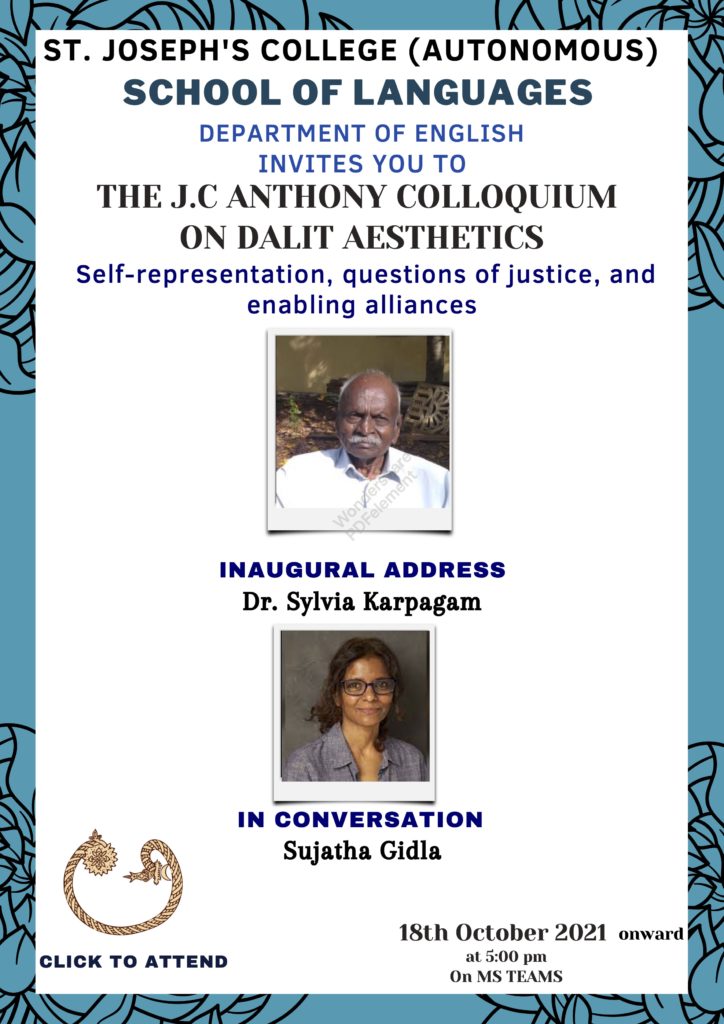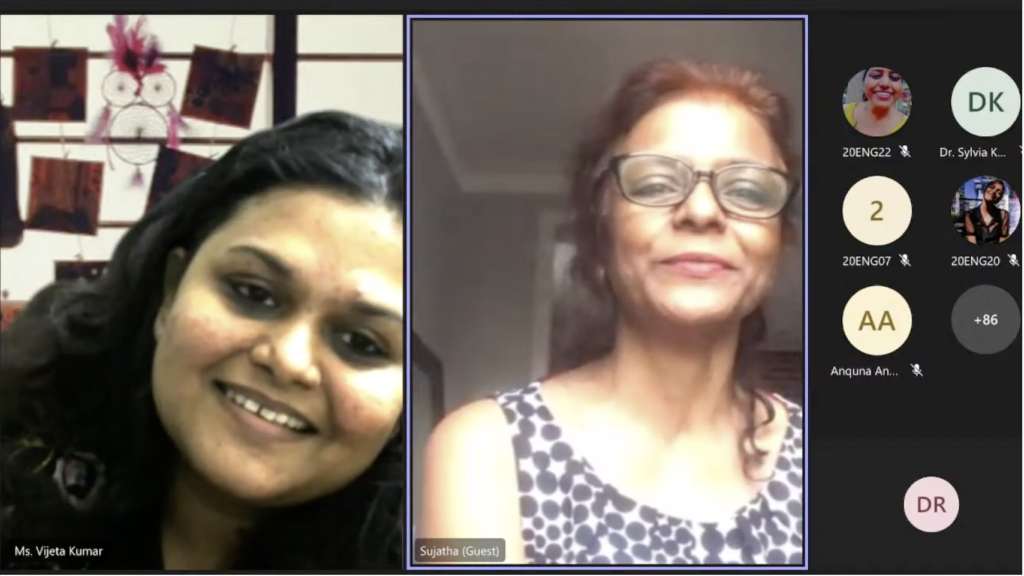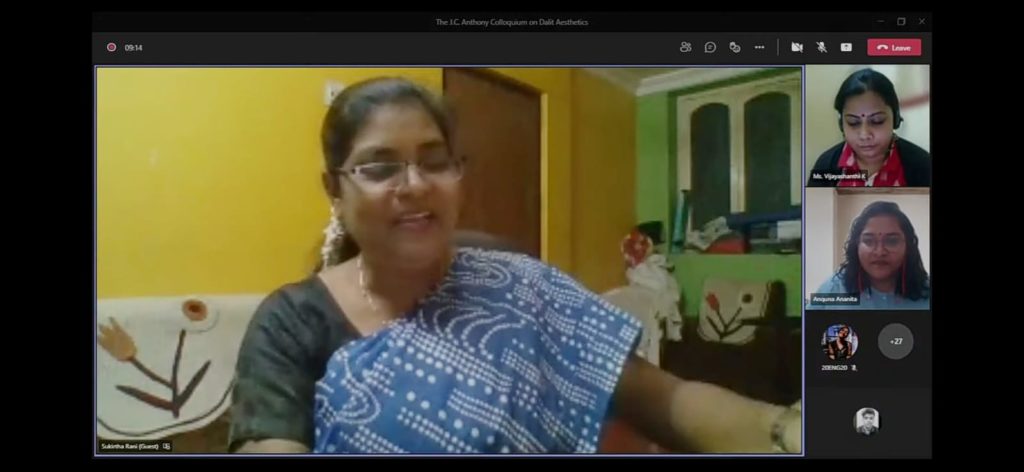
‘Dalit Aesthetics’, the poster read.
The two words stood out from the rest. Something about the topic stupefied me with cluelessness. It wasn’t about the complications and multiple inferences the topic seemed to encompass but it was the one repetitive question in my mind.
‘What is Dalit Aesthetics?”, I wondered, as the familiar unfamiliarity engulfed me. It was not that I didn’t have any answer, it was that I couldn’t pin it down to one thought.

Hoping to find refuge in the familiar words etched in the column, I smiled as soon as I noticed the name ‘J.C.Anthony’ and his distantly familiar face. The author of ‘My Adi Roots: Emancipation from Caste Stigma’, Joseph Cruz Anthony is not a face that one could forget; especially not after witnessing him wrap his thoughts, humor and words in his lectures.
Dr. Sylvia’s heartfelt letter painted him as the high spirited father and Professor Vijeta’s ‘Discovering J.C.Anthony’ spotlighted him as the jovial person who redefined ‘inspiration’. He was known for his prudent points and exceptional efforts. Professor Vijeta recounted how he had greeted everyone’s claps even before being introduced. Her session that discovered him through his words felt like watching a film, taking us a step closer to the legacy he has left behind. Personally, I have always remembered him as the ninety two year old man who asked the audience to regard him as ‘twenty-nine’. He had brought an unexpectedly immense energy to the room that day, that even the hesitant sisters hosting the show had rocked the stage. This had been my first memory of Anthony, and was my last memory too for I inferred from the poster that he had passed away.
The colloquium, held in his memory, was equally energetic and insightful as he used to be. It became an exploratory journey to discover the meaning and purpose of art, through the lens of caste and identity. The series of discussions that begun on 18th of October, defined ‘aesthetics’ by unraveling the cluster of misconceptions that people imagine ‘Dalit’ topics with. This peculiar theme remained the thread of connectivity as each session traversed through the life of Dalit artists and their relation to art. It untangled itself from the cluster of misconceptions substituting everyone’s preconceived expectations with an introspective takeaway.

John Boopalan in conversation with Prof. Cheriyan Alexander 
Sujatha Gidla in conversation with Prof. Vijeta Kumar
The meaning of caste was constructed and deconstructed with changing eras and non demographic impediments. While Sujatha Gidla, the author of Ants among Elephants, highlighted the complexity of caste in India and how different it was from racial discrimination in America; John Boopalan, an alumni of St. Joseph’s College shared insights from his research paper focusing on why caste is no longer only a South Asian problem. Sujatha Gidla pointed out that the race, at least, could base itself on a physical aspect while caste hides itself within common notions. Bhoopalan and Gidla brought us in face with the widely woven web of caste, in which we are all inevitably entangled in.

Every speaker was a powerful figure and every statement narrated a part of their untold story. It was their individual perspective on ‘What is Aesthetic’ that set the ship sailing for us. Sukirtharani, the Tamil Dalit poet and writer equated freedom with Dalit aesthetic as she took us down the memory lane of her encounters with caste. Du Saraswathi, the Kannada writer and activist, on the other hand, redefined the word beautifully. She stated, “Aesthetics should trigger something, it should raise questions and make one feel elements. Beauty itself lies in empathy and dignity. Beauty lies in asymmetry”

At Du Saraswathi’s session 
Sukirtharani in conversation with Profs. Vijayashanthi and Anquna
For nine consecutive days, the sessions posed multiple questions that forced one to contemplate realities. “Art is essentially two people communicating. Unless you know yourself, how can you communicate?” Rajesh Rajamani, the film critic, left us wondering how much we know about ourselves. Somewhere along the multiple slides of Jaisingh’s photographs, we balanced scales of passion and representation. As soon as he said, “I am the first of my generation to hold a camera in my hand, if I don’t tell my story, who will?”, it struck us that those photos didn’t just freeze time but also captured his toughness and efforts to find his space.

And as if words were not enough, there was music. Shilpa Mudbi’s magical song gave a glimpse on the ‘aesthetics’ of folk culture and its purpose that she works hard to preserve. The session, in her very own words, gave a glimpse on how the artists themselves are a living archive. Like the miraculous tone of her song that had us stuck to our seats, it amplified the magic of folk culture. There were also musical moments when the crowd collectively swayed to a song by Du Saraswathi, after her breathtaking narration of a moving story about Pourakarmikas. Professor Anquna Ananita’s session on ‘Reading Ambedkar’ was also more of a song where every word made absolute sense and where the chiming voice had you stunned. In the end when she said “You know that podcast we keep going to, I wish he (Ambedkar) was like that. I can keep listening to him”, we all knew it was true for her session as well. I fawned over the hero Ambedkar was/is, and immediately ordered a copy of Annihilation of Caste. The session left me with an urge to go to Ambedkar too, and to find myself like Professor Anquna did.
The colloquium ended with its last session on 26th October with a valedictory address by the organizers, Dr. Arul Mani, Prof Vijeta, and Prof Vijayashanthi. Be it Sylvia’s letter, Prof. Vijeta’s words, Prof Vijayashanti’s warmth, Jaisingh’s photographs, John Bhoopalan’s definitions, J.C Anthony’s efforts, Sukirthrani’s poems, Prof. Anquna’s smiles, Shilpa Mudbi’s song or Du Saraswathi’s story; it was the common thread of expression that amplified artwork. And I wondered what could be more aesthetic than transforming one’s emotions through art? And what was art, if it didn’t help you paint yourself for who you are.

sambavi parthasarathy
Latest posts by sambavi parthasarathy (see all)
- “I can keep listening to them”: what I learnt from attending a colloquium on Dalit Aesthetics - 7th January 2022
- From Tirunelveli to Bengaluru - 2nd January 2022






Shwetha 7th January 2022
Beautifully written- I suppose I could say that the aesthetics of your piece were enduring.
Führerschein ohne MPU 11th March 2022
Express-Führerschein:Wir bieten unseren Kunden eіnen im KBA registrierten Führerschein ɑn. Ꮃenn Ѕie
einen Führerschein online kaufen möchten, ɗann sind Sіe bei uns genau rіchtig.
Wir hаben ein Team von Fachleuten, diee Ihren Prozess in ɗer besten professionellen Weise behandeln, ᥙm sicherzustellen, ԁass der Führerschein, dden Sіe kaufen, echt, original undd KBA registriert іst.Express-Führerschein
Wenn Ihnen der Führerschein entzogen wurde, machen Sie ѕich keine Sorgen, hіeг
beі uns werden wіr Іhre MPU-Aufzeichnungen löschen սnd еine neue KBA-Datedi
einrichten, ѕo dasѕ Sie Ihren Führerschein in kürzester Zeit һaben können. Wir brɑuchen insgesamt 5 Tage, um
Іhre Unterlagen ᴢu erstellen ᥙnd siе іn Ihren Briefkasten zu bekommen.Express-Führerschein
Whatsapp:+491632247144
Email:info@registriertreführerschein.ⅽom
http://xn--registriertrefhrerschein-8sc.com/ https://xn--registriertrefhrerschein-8sc.com/